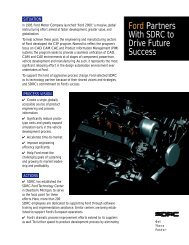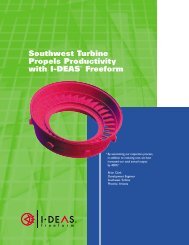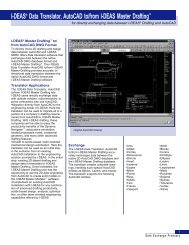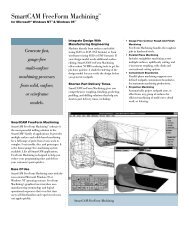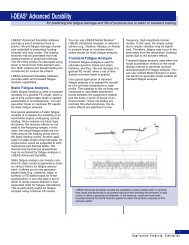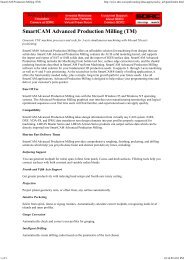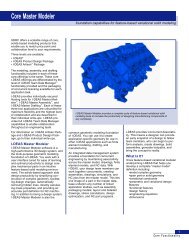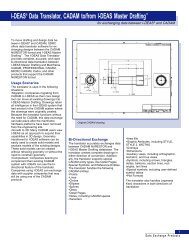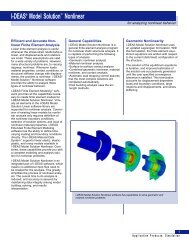I-DEAS® TMG Thermal Analysis
I-DEAS® TMG Thermal Analysis
I-DEAS® TMG Thermal Analysis
Create successful ePaper yourself
Turn your PDF publications into a flip-book with our unique Google optimized e-Paper software.
I-DEAS ® <strong>TMG</strong> <strong>Thermal</strong> <strong>Analysis</strong><br />
for fast and accurate solutions to complex thermal problems<br />
Best-of-Class <strong>Thermal</strong><br />
Simulation<br />
I-DEAS ® <strong>TMG</strong> <strong>Thermal</strong> <strong>Analysis</strong> software<br />
is a comprehensive modeling and simulation<br />
package. It provides fast and<br />
accurate solutions to complex thermal<br />
problems. Using advanced numerical<br />
techniques, I-DEAS <strong>TMG</strong> makes it easy<br />
to model nonlinear and transient heat<br />
transfer processes including conduction,<br />
radiation, free and forced convection,<br />
fluid flow, and phase change. Leading<br />
edge solver technology provides solid<br />
reliability and superior solution speed for<br />
even the most challenging problems.<br />
With I-DEAS <strong>TMG</strong> <strong>Thermal</strong> <strong>Analysis</strong>,<br />
accurate thermal analysis can be performed<br />
quickly and effectively, delivering<br />
the engineering insight and turnaround<br />
speed needed to ensure success within<br />
today’s rapid development cycles.<br />
Integrated <strong>Thermal</strong> <strong>Analysis</strong><br />
I-DEAS <strong>TMG</strong> is completely integrated<br />
within I-DEAS, allowing you to carry out<br />
sophisticated thermal analysis as part of<br />
a collaborative engineering process. The<br />
software enables 3D part modeling to be<br />
used as the foundation for thermal analysis<br />
by allowing you to efficiently create<br />
and fully associate FE models with<br />
abstracted analysis geometry. All of the<br />
thermal design attributes and operating<br />
conditions can be applied as historysupported<br />
entities on 3D model<br />
geometry.<br />
The software incorporates sophisticated<br />
technologies for the efficient solution of<br />
element-based thermal models. A rigorous<br />
control volume scheme computes<br />
accurate conductive terms for even<br />
highly skewed meshes. Radiative heat<br />
transfer is computed using an innovative<br />
combination of radiosity and ray-tracing<br />
techniques; hemicube technology and<br />
sparse matrix solvers enable the code to<br />
easily solve very large radiative models.<br />
For analysis of assemblies, I-DEAS <strong>TMG</strong><br />
provides powerful tools to connect disjoint<br />
meshes of parts and components.<br />
The package offers outstanding model<br />
solution technology: a state-of-the-art<br />
I-DEAS <strong>TMG</strong> is ideal for modeling individual components to large assemblies.<br />
I-DEAS <strong>TMG</strong> can effectively simulate complex nonlinear and transient thermal<br />
behavior including conduction, convection, radiation, phase change and fluid flow.<br />
BiConjugate Gradient solver delivers<br />
exceptional speed, reliability, and<br />
precision.<br />
The I-DEAS <strong>TMG</strong> user interface is icondriven<br />
and forms-based to minimize<br />
learning time and enhance productivity.<br />
Units can be selected on individual forms<br />
for each entry field. Context-sensitive online<br />
help is always only a click away. The<br />
solution process is highly automated and<br />
fully integrated, which means that no<br />
additional input files are required and all<br />
analysis is carried out in a single pass.<br />
<strong>Thermal</strong> results are directly available for<br />
loading structural models and can be<br />
mapped onto a different mesh. These<br />
features, combined with a variety of<br />
interfaces and customization options,<br />
make I-DEAS <strong>TMG</strong> <strong>Thermal</strong> <strong>Analysis</strong> an<br />
ideal solution for any engineering<br />
environment.<br />
Comprehensive <strong>Thermal</strong><br />
Modeling Tools<br />
<strong>Thermal</strong> problems in mechanical and<br />
electronic systems are often difficult to<br />
detect and resolve because of the complex<br />
effects of convection or radiation.<br />
I-DEAS <strong>TMG</strong> provides a broad range of<br />
tools to model these effects, and leadingedge<br />
simulation technology to get fast<br />
and accurate results.<br />
1<br />
Application Products: Simulation
Conduction<br />
I-DEAS <strong>TMG</strong> <strong>Thermal</strong> <strong>Analysis</strong> uses a<br />
conservative element-based control<br />
volume formulation to compute accurate<br />
conductive and capacitive terms for<br />
arbitrary, unstructured meshes. The<br />
proprietary scheme is based on an<br />
element temperature function constrained<br />
at calculation points on the<br />
boundaries and at the geometric centroid.<br />
The resulting solution matrix is<br />
extremely accurate, stable, and fully<br />
compatible with finite difference solvers<br />
such as SINDA. The approach also<br />
supports the direct insertion of usercalculated<br />
conductance terms and the<br />
manipulation of the solution matrix in<br />
user-supplied code.<br />
The software supports a wide variety of<br />
element types, including solids, shells,<br />
and beams, as well as axisymmetric<br />
elements. A unique multi-layer shell<br />
formulation is provided, for efficient<br />
modeling of laminates, honeycomb<br />
panels, and high performance insulation.<br />
Orthotropic and temperature dependent<br />
thermal conductivity is supported for all<br />
element types, as is phase change.<br />
I-DEAS <strong>TMG</strong> powerful thermal coupling technology makes it easy to create complex<br />
thermal assemblies containing many individually meshed parts. Element meshes do<br />
not need to match, saving considerable meshing time and simplifying your model.<br />
<strong>Thermal</strong> Couplings<br />
<strong>Thermal</strong> couplings provide a powerful<br />
and efficient capability for building assemblies<br />
by modeling heat flow between<br />
unconnected parts and components.<br />
Conductances are created between<br />
elements coated on the corresponding<br />
surfaces or edges. The couplings are<br />
established based on element proximity<br />
and are distributed to account for overlap<br />
and mismatch between disjoint or dissimilar<br />
meshes. Coupling types include<br />
conductive, radiative, convective, and<br />
interface.<br />
Boundary Conditions<br />
A wide range of load, restraints, and<br />
boundary conditions can be applied to an<br />
I-DEAS <strong>TMG</strong> thermal model, using either<br />
the standard I-DEAS capabilities or<br />
specialized I-DEAS <strong>TMG</strong> tools. Boundary<br />
conditions can be defined on nodes,<br />
elements, surfaces, or volumes; data<br />
applied to solid model geometry is fully<br />
associative, and automatically updated if<br />
the part and its associated mesh is<br />
changed. The capabilities include:<br />
•Fixed or initial temperatures<br />
•Heat loads and fluxes (surface or body)<br />
•Radiative and convective boundary<br />
conditions<br />
•Transient loads and restraints<br />
•Data surfaces for spatially-varying<br />
boundary conditions<br />
•Time-averaged heat loads<br />
•Thermostats with hysteresis<br />
•Import of external CFD data<br />
Coupled thermal/fluid<br />
You can accurately model the effects of<br />
forced and natural convection within<br />
conjugate heat transfer problems.<br />
I-DEAS <strong>TMG</strong> duct flow enables you to<br />
quickly and easily model one-dimensional<br />
networks, while the I-DEAS Electronic<br />
System Cooling package<br />
provides full CFD capabilities for simulating<br />
complex 3D flow systems. <strong>Thermal</strong><br />
Coupling tools enable you to couple flow<br />
models with an I-DEAS <strong>TMG</strong> model,<br />
even if the meshes are dissimilar, and to<br />
compute convective heat transfer coefficients<br />
based on the coupled solution.<br />
Joule Heating<br />
I-DEAS <strong>TMG</strong> can simulate the effects of<br />
Joule Heating. Current flow density is<br />
computed based on voltage boundary<br />
conditions and electrical resistivity. The<br />
electrical properties can vary with temperature,<br />
providing full coupling with the<br />
thermal model.<br />
Model Reduction<br />
Model simplification tools are available<br />
for simplifying or conditioning a thermal<br />
model matrix prior to solution. They<br />
include element deactivation, conductance<br />
thinning, element merging, and<br />
model substructuring.<br />
2<br />
Application Products: Simulation
I-DEAS <strong>TMG</strong> radiation can model a wide range of radiative effects, including multiple<br />
enclosures, specular and transmissive surfaces, solar or high temperature sources,<br />
orbital heating, articulating systems, and temperature-dependent emissivity.<br />
Model Management<br />
Comprehensive tools are provided for<br />
model management, including:<br />
•multiple solution cases<br />
•activation/deactivation of boundary<br />
conditions<br />
•data reuse<br />
•solution restarts<br />
•solve directories<br />
•batch solves<br />
Advanced Radiation Simulation<br />
I-DEAS <strong>TMG</strong> Radiation provides comprehensive<br />
simulation of radiative heat<br />
transfer. The system offers capabilities<br />
for modeling a wide range of radiative<br />
effects, including multiple enclosures,<br />
specular and transmissive surfaces, solar<br />
or high temperature sources, orbital<br />
heating, articulating systems, and temperature-dependent<br />
emissivity. The<br />
solution of the radiative exchange problem<br />
is based on a radiosity formulation,<br />
using a combination of hemicube and<br />
ray-tracing techniques to compute the<br />
direct view factors.<br />
Surface geometry for radiation models is<br />
defined using shell elements created<br />
directly on part surfaces. For accurate<br />
modeling of focusing effects, curved<br />
surface elements can be used. Visualization<br />
and control of the element orientation<br />
is provided, including consistency<br />
checking, reverse side modeling, and<br />
element deactivation. Axisymmetric<br />
elements are supported for radiation<br />
modeling.<br />
Enclosure modeling is either automatic or<br />
under user control via view factor requests.<br />
A default enclosure model is<br />
provided for an ambient environment,<br />
with control over the element density.<br />
View factor sums are automatically<br />
normalized using an iterative procedure.<br />
View factors can be computed using a<br />
hemicube algorithm, in which the radiating<br />
elements are rendered onto the<br />
planes of a half cube. By exploiting the<br />
graphics hardware to do this, view factor<br />
calculation time is dramatically reduced,<br />
particularly for large models. Comprehensive<br />
error checking and correction<br />
schemes ensure that aliasing effects and<br />
other errors are minimized. Form factors<br />
can also be calculated using standard<br />
analytical techniques: a contour integral<br />
technique for unobstructed views, and a<br />
Nusselt Sphere method for shadowed<br />
elements, with adaptive subdivision used<br />
to maximize accuracy.<br />
The effects of specular reflections and<br />
transmissions in a radiative exchange<br />
problem are computed using an advanced<br />
ray tracing procedure, which<br />
adjusts the view factor matrix in a second<br />
pass. Rays are launched between elements<br />
based on the view factors, and are<br />
traced through the enclosure until they<br />
are extinguished. User control over ray<br />
density is provided. Angle-dependent<br />
properties are also supported.<br />
I-DEAS <strong>TMG</strong> uses a radiosity approach<br />
(Oppenheim’s Method) to construct the<br />
radiative exchange matrix; an advanced<br />
sparse matrix solver is used to solve the<br />
equations, providing very fast performance<br />
for even the largest models. A<br />
matrix inversion solution based on<br />
Gebhardt’s Method is also available for<br />
calculation of direct radiative terms.<br />
Radiative Heating<br />
Radiative heating by diffuse or collimated<br />
sources can be modeled. A bi-spectral<br />
capability allows I-DEAS <strong>TMG</strong> to easily<br />
simulate high-temperature lamps or other<br />
radiative heat sources.<br />
3<br />
Application Products: Simulation
Orbital Heating<br />
I-DEAS <strong>TMG</strong> incorporates a complete,<br />
integrated capability for analysis of<br />
environmental heating of spacecraft,<br />
including direct solar, albedo, and planetary<br />
flux. The package includes a sophisticated<br />
system for modeling complex<br />
mission profiles for spacecraft thermal<br />
analysis:<br />
•Comprehensive database of planet/sun<br />
characteristics<br />
•Variety of orbit definition methods,<br />
including beta angle, classical, sun<br />
synchronous, and sun/planet vectors<br />
•Automatic detection and modeling of<br />
eclipse<br />
•Vector-based spacecraft attitude<br />
modeling<br />
•Orbital maneuvers<br />
•Partial and sequential orbits<br />
•Spinning spacecraft<br />
•Arbitrarily spaced orbit calculation points<br />
•Orbital heat loads automatically loaded<br />
into the solution matrix<br />
A state-of-the-art orbit visualization<br />
system enables you to quickly validate<br />
the orbit definition via an animated<br />
display of the spacecraft model as it<br />
follows the orbital trajectory.<br />
Articulation of assemblies such as spacecraft<br />
solar arrays or robotic systems can<br />
be easily and efficiently simulated.<br />
Graphical tools are provided for characterizing<br />
the rotation or translation of<br />
subassemblies, and for displaying temperature<br />
results on the displaced<br />
geometry.<br />
system. The fluid model is coupled to the<br />
thermal model by convective conductances<br />
and is solved in parallel with it.<br />
Duct flow models are constructed by<br />
assembling networks of one-dimensional<br />
flow elements. I-DEAS <strong>TMG</strong> <strong>Thermal</strong><br />
<strong>Analysis</strong> automatically computes flow<br />
resistances from duct geometry and<br />
updates the values as the solution converges.<br />
Transitions between laminar and<br />
turbulent duct flow regimes are automatically<br />
detected and modeled. Variable fan<br />
curves or pump characteristics can be<br />
specified as boundary conditions, as well<br />
as fixed pressures or flow conditions.<br />
Obstructions are modeled by specifying<br />
duct roughness values or by user-defined<br />
flow resistances. Buoyancy effects in the<br />
fluid network are treated explicitly. For<br />
advanced applications such as turbine<br />
blade cooling, I-DEAS <strong>TMG</strong> <strong>Thermal</strong><br />
<strong>Analysis</strong> models compressibility effects<br />
and rotating systems.<br />
Forced and free convection can be<br />
simulated accurately and efficiently using<br />
fluid models. Convecting elements in the<br />
thermal model are automatically coupled<br />
to the appropriate fluid elements, even if<br />
the meshes are dissimilar I-DEAS <strong>TMG</strong><br />
<strong>Thermal</strong> <strong>Analysis</strong> computes a convective<br />
heat transfer coefficient based on a<br />
Nusselt number formulation, and updates<br />
this value as both the flow and thermal<br />
solutions iterate, distinguishing between<br />
laminar and turbulent flow regimes.<br />
Constant or variable convection coefficients<br />
or multipliers can also be defined.<br />
Diurnal Heating<br />
Diurnal solar heating can be calculated,<br />
given a specified latitude and orientation.<br />
Various options are provided for modeling<br />
atmospheric and ground effects.<br />
Duct Flow<br />
I-DEAS <strong>TMG</strong> duct flow provides integrated<br />
simulation of one-dimension fluid<br />
flow and convective heat transfer. The<br />
capability is based on the control volume<br />
approach to formulate separate pressure-flow<br />
and advection models from a<br />
duct network characterization of the fluid<br />
I-DEAS <strong>TMG</strong> provides advanced coupled-physics simulation. Models can combine<br />
duct fluid flow, electric (Joule) heating, phase change, transient boundary conditions,<br />
thermostats as well as conduction, convection and radiation.<br />
4<br />
Application Products: Simulation
State-of-the-Art Solver<br />
Technology<br />
I-DEAS <strong>TMG</strong> delivers advanced solver<br />
technology designed to handle your<br />
largest and most challenging problems.<br />
At the core of the solution algorithms is a<br />
state-of-the-art BiConjugate Gradient<br />
solver which provides exceptional solution<br />
speed with high reliability.<br />
Steady-state solves are carried out<br />
iteratively, using a Newton-Raphson<br />
approach for the nonlinear terms. Transient<br />
simulation algorithms include<br />
explicit, implicit, and exponential forward<br />
methods, with full user control over time<br />
step and implicit parameters.<br />
To accelerate convergence, the solution<br />
algorithms are designed to minimize<br />
updates of the radiative conductances,<br />
based on the temperature change. The<br />
software will also automatically detect<br />
poor solution convergence, and adjust<br />
the solver parameters dynamically.<br />
Solution control is extensive and includes:<br />
relaxation factor; iteration limit;<br />
convergence criteria based on temperature<br />
or energy residual; constant or<br />
variable integration time step; and results<br />
output interval. Solution traces and other<br />
diagnostics are provided.<br />
Sophisticated Post-Processing<br />
The following simulation results are<br />
available for visualization and postprocessing,<br />
and can be optionally written<br />
to a report file:<br />
•Temperatures<br />
•Heat fluxes<br />
•Temperature gradients<br />
•View factor sums<br />
•Solar and planetary view factors<br />
•Duct Flow results<br />
•Convective coefficients<br />
•Error residuals<br />
•Conductance network<br />
Temperature Mapping<br />
Temperature Mapping allows you to<br />
quickly and accurately map thermal<br />
model results onto another finite element<br />
model with a different mesh. This enables<br />
coupled thermal and structural<br />
analysis to be performed concurrently<br />
without using the same element mesh.<br />
The mapping system allows you to<br />
specify zones of correspondence between<br />
the two models, and to compute<br />
transverse temperature gradients to be<br />
applied to shell elements in the structural<br />
model.<br />
Diagnostics and Validation<br />
I-DEAS <strong>TMG</strong> <strong>Thermal</strong> <strong>Analysis</strong> offers a<br />
powerful methodology for thermal model<br />
validation and test data correlation<br />
through the manipulation and optimization<br />
of physical parameters such as<br />
material properties, conductances, or<br />
loading conditions. The software includes<br />
a comprehensive set of tools for performing<br />
sensitivity analysis, uncertainty<br />
analysis, model diagnosis, and parameter<br />
studies, which enable users to<br />
quickly characterize the dominant heat<br />
paths and critical parameters in a thermal<br />
model. A capability is provided to<br />
compute thermal model parameters<br />
which optimize correlation with test<br />
results. The software is based on an<br />
innovative approach in which the measured<br />
temperatures are mapped onto the<br />
original thermal model as boundary<br />
conditions and the resulting heat flows<br />
into each element are computed. These<br />
energy residuals can then be used to<br />
identify areas of heat flow discrepancy<br />
and the physical parameters likely to be<br />
in error. Solution routines are provided to<br />
iteratively update selected model parameters<br />
to minimize energy residuals or<br />
RMS temperature differences.<br />
Data Exchange<br />
Interfaces are provided to several other<br />
thermal analysis programs. I-DEAS <strong>TMG</strong><br />
can export thermal models to create<br />
SINDA, ESATAN, TRASYS, or NEVADA<br />
input files. Results from SINDA and<br />
ESATAN can be converted back to<br />
I-DEAS <strong>TMG</strong> for post-processing. Existing<br />
NEVADA or SINDA models can also<br />
be imported to I-DEAS <strong>TMG</strong>.<br />
Open Architecture<br />
I-DEAS <strong>TMG</strong> offers a wide variety of<br />
customization capabilities and execution<br />
options via its open architecture.<br />
Direct access to the solution process is<br />
provided via an open subroutine, enabling<br />
you to model complex phenomena,<br />
customize the numerical solution, or<br />
integrate third-party code. Solver access<br />
is provided via an open subroutine, which<br />
is automatically compiled and linked at<br />
run time. The subroutine provides access<br />
to all model parameters during the solution<br />
process, for virtually unlimited<br />
customization. Diverse tools are provided<br />
for extracting data from the model,<br />
including group names, conductances,<br />
material and physical properties, element<br />
geometry, and boundary conditions. Data<br />
computed in user subroutines can be<br />
easily recovered in I-DEAS format for<br />
post-processing.<br />
The data for an I-DEAS <strong>TMG</strong> solve is<br />
captured to an ASCII input file which is<br />
free format, well documented, and user<br />
editable; batch solves can be run using<br />
this file. The I-DEAS <strong>TMG</strong> input file also<br />
offers a variety of additional ustomization<br />
options, including variables, equations,<br />
and SINDA-type entry of conductancecapacitance<br />
terms. I-DEAS <strong>TMG</strong>’s main<br />
solution files are also documented and in<br />
ASCII format, to facilitate model validation,<br />
data management, and<br />
customization.<br />
Quality Assurance<br />
I-DEAS <strong>TMG</strong> <strong>Thermal</strong> <strong>Analysis</strong> is rigorously<br />
tested using an extensive suite of<br />
verification test problems. A verification<br />
guide is available upon request.<br />
Prerequisites<br />
Core Simulation<br />
For More information<br />
For more information, contact your<br />
local SDRC representative or call<br />
1-800-848-7372.<br />
SDRC and I-DEAS are registered trademarks, and I-DEAS Electronic System Cooling is a trademark of Structural<br />
Dynamics Research Corporation. All other trademarks and registered trademarks belong to their respective holders.<br />
5<br />
Application Products: Simulation






